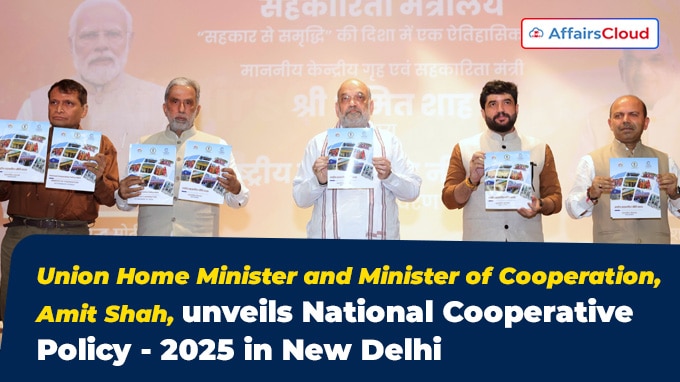 In July 2025, Union Minister Amit Shah, representing the Ministry of Home Affairs(MHA) and Ministry of Cooperation, launched the ‘National Cooperative Policy 2025’ at an event held at Atal Akshay Urja Bhawan in New Delhi, Delhi. This policy marks a significant milestone for India’s cooperative movement, setting the direction for the next two decades (2025-2045).
In July 2025, Union Minister Amit Shah, representing the Ministry of Home Affairs(MHA) and Ministry of Cooperation, launched the ‘National Cooperative Policy 2025’ at an event held at Atal Akshay Urja Bhawan in New Delhi, Delhi. This policy marks a significant milestone for India’s cooperative movement, setting the direction for the next two decades (2025-2045).
- It encourages technology-driven, transparent, accountable, and self-reliant cooperatives, with legal frameworks updated every 10 years.
Key People:
Union Ministers of State(MoS) Krishan Pal Gurjar and Murlidhar Mohol, Ministry of Cooperation; Dr. Ashish Kumar Bhutani, Secretary of Ministry of Cooperation; Suresh Prabhu, former Union Minister and chairman of drafting committee of new Cooperation Policy, and many other dignitaries were present in this occasion.
Background:
First National Cooperative Policy: In 2002, India introduced its first National Cooperative Policy, providing a foundational framework aimed at improving the management of the economic activities of cooperative institutions across the country.
Need for Update: The new policy will replace the old framework to keep up with changes in the cooperative sector caused by globalization and rapid technological progress over the past 20 years.
- The Ministry of Cooperation has identified 83 intervention points, with progress on most to enhance transparency and governance.
About National Cooperative Policy 2025:
Vision: It is to build a Viksit Bharat by 2047 through ‘Sahkar Se Samriddhi’ (prosperity through cooperation).
- The core focus remained on the development of 1.4 billion (bn) people of India, especially villages, agriculture, rural women, Dalits, and tribals.
Mission: The mission is to promote small cooperative units that are professional, transparent, technology-enabled, accountable, economically self-reliant, and successful and to ensure at least one cooperative unit is established in every village.
Committee: Under the leadership of Suresh Prabhu, a 40-member committee presented a comprehensive and visionary cooperation policy to India’s cooperative sector.
- The committee conducted regional workshops and held extensive discussions with cooperative leaders, experts, academicians, ministries, and all other stakeholders to draft the policy.
- The committee gathered around 750 suggestions, conducted 17 meetings, and, following consultations with the Reserve Bank of India and National Bank for Agriculture and Rural Development (NABARD), finalized the policy.
Sectors: The Ministry of Cooperation has prepared a detailed plan for sectors like tourism, taxi services, insurance, and green energy.
- The profits generated through the cooperative units participating in the above sectors will ultimately reach the members of Primary Agricultural Credit Societies (PACS) at the rural level.
Targets: The target is to triple the contribution of the cooperative sector to India’s Gross Domestic Product (GDP) by the year 2034.
- Also bring 50 crore citizens, who are either not members or are inactive in the cooperative sector, into active participation.
- Additionally, there is a target to increase the number of cooperative societies by 30% from the current count of 8.3 lakh.
Six Pillars: The 6 pillars that have been defined to achieve the goals for the cooperative sector are:
- Strengthening the foundation,
- Promoting vibrancy,
- Preparing cooperative societies for the future,
- Enhancing inclusivity and expanding reach,
- Expanding into new sectors, and
- Preparing the younger generation for cooperative development.
Initiatives:
Model Cooperative Village (MCV): Union Minister Amit Shah announced plans to establish five model cooperative villages in every tehsil (taluk) with the support of state cooperative banks.
- The Model Cooperative Village initiative, launched by the NABARD, began in Gandhinagar, Gujarat.
National Cooperative Exports Limited (NCEL): It has been established to achieve global outreach and access to international markets.
Sahkar Taxi: A taxi-service cooperative will be formed by willing taxi drivers and the management will rest with the members of such society.
- The objective of this initiative is to ensure that maximum profit earned by such a cooperative taxi society is distributed equitably among the taxi drivers who will be members of that society.
PACS: The MoC informed that the work of setting up 45,000 new PACS is nearly complete, and their computerization has also been accomplished. He further mentioned that so far:
- 4,108 PACS have been approved to open Pradhan Mantri (PM) Jan Aushadhi Kendras,
- 393 PACS have applied to run petrol and diesel retail outlets,
- over 100 PACS have applied for Liquefied Petroleum Gas (LPG) distribution, and
- PACS are also working on managing the “Har Ghar Nal Se Jal” (tap water to every home) scheme and the PM Surya Ghar Yojana.
- Establish 2,00,000 Primary Agricultural Credit Societies (PACS) by February 2026, aiming to extend cooperative services to every village across India.
Tribhuvan Sahkari University: The foundation for this university has been laid to provide trained manpower for all the above activities.
Important Schemes:
PM Jan Aushadhi Kendras: These are medicine shops opened to provide quality generic medicine at affordable prices. It was launched in 2008.
PM Surya Ghar Yojana: The scheme was launched in 2024 to provide subsidies to the households to install solar panels on their roofs.
Har Ghar Nal Se Jal: Introduced in 2019, to make provision of tap water supply to every rural household by 2024.




